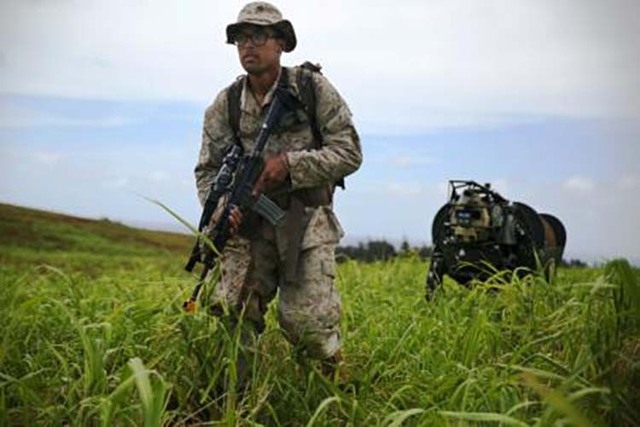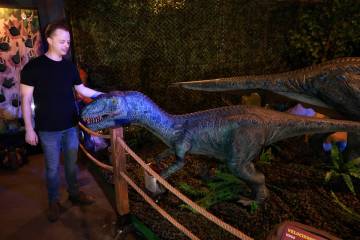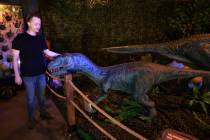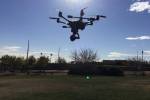Henderson Marine’s niche: robotic pack mule
When Brandon Dieckmann left Henderson in 2010 to join the Marines, he “wanted to do some traveling, get out and see the world and do something different.”
Flash forward four years and the lance corporal has found his niche in Hawaii doing something really different from what riflemen are accustomed to: operating a cutting-edge robotic pack mule, one that promises to change how the Marines conduct field operations.
Officially called the Legged Squad Support System (LS3), it functions like its name implies, said Dieckmann, 22. “It has four legs and resembles a mule or fat horse, and has different grips you can put on its feet.
“When it moves, it doesn’t move as gracefully as an actual animal. It prances,” he said in an interview this month, after returning from July’s Pacific Rim exercise that included an advanced war-fighting experiment in the grassy, Kahuku Training Area, on Ohau, a 40-minute drive north of Pearl Harbor.
Although its manufacturer, Boston Dynamics, envisioned naming the robot Mastiff after a large dog breed, Dieckmann said his comrades in India Company, 3rd Battalion, 3rd Marine Regiment, refer to it as Cujo, a dog from a Stephen King novel.
Depending on the volume and shape of items, the robot can haul from 400 to more than 600 pounds of water and fuel in jugs, ammunition and supplies. “As long as it fits we can carry water, food, ammo,” said Dieckmann, a 2010 graduate of Coronado High School.
The robot is programmed to track its operators’ steps using an infrared sensor that detects receiver strips on the Marine’s backpack. It can range from five to 15 meters behind the operator, or the operator can use a joystick to control movements ahead of the platoon.
“It follows you where you go,” he said.
Or, in the lead operating mode, the $2 million robot can set a fast-clip pace. “We can take it out on flat terrain at 10 kilometers per hour, fast enough that we have to jog to keep up with it at full speed.”
Nevada has been a proving ground for remote-controlled aircraft with potential for enhancing military operations while keeping troops out of harm’s way.
The era of drones, or remotely piloted aircraft, was spawned in the late 1990s at what is now Creech Air Force Base It is where pilots and sensor operators first sat at computer consoles inside the safety of ground-control stations to fly the Predator aircraft that fired the first Hellfire missiles on tank targets miles from the base.
Now Predators and larger Reapers that carry smart bombs as well as missiles are routinely used for missions over trouble spots in the Middle East and Southwest Asia.
After they are launched from bases overseas, the drones are controlled thousands of miles away by operators in ground stations at Creech and other U.S. locations via satellite links.
Experimental remote-controlled vehicles hit the ground in Nevada in 2004 when the Defense Advanced Research Projects Agency held a $1 million Grand Challenge. The competition was designed to spur private interest in developing robotic vehicles for troops on the ground. More than 80 teams submitted technical papers to qualify for the race across the Mojave Desert between Barstow, Calif., and Las Vegas.
Vehicles in the competition varied from a heavily modified military surplus High Mobility Multi-purpose Wheeled Vehicle, to autonomous ATVs to a sand rail with a dozen different computer sensors on board. The field was narrowed to 25 robotic vehicles that were supposed to travel 150 miles across the rugged desert terrain. But only 13 teams started the race. Not a single vehicle made it more than seven miles, and some vehicles only made a few hundred yards.
While there were lessons learned from the Grand Challenge, Boston Dynamics wasn’t part of the contest. Instead, the company developed the Legged Squad Support System through its own initiative.
It had been tested by the Marines at the Army at other locations but the July exercise on Oahu was its first major exercise. Two types of robotic pack mules were used: one powered by gasoline and the other by batteries.
Dieckmann said his robot performed “better than most people thought it would do” but there are kinks to be worked out.
At times, he said, “It got harry, not so much with terrain but with vegetation and vines wrapped around its feet and legs. But negotiating sharp turns and steep hills, it can do it.”
“To me, I see the technology as not all there yet,” he said, adding that it might be a decade or more before it’s perfected.
Contact Keith Rogers at krogers@reviewjournal.com or 702-383-0308. Find him on Twitter: @KeithRogers2.





























